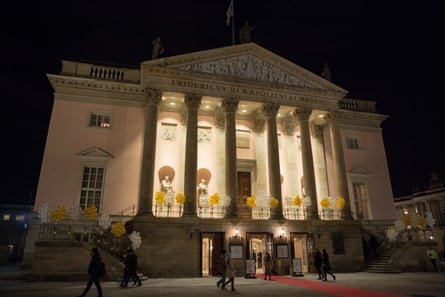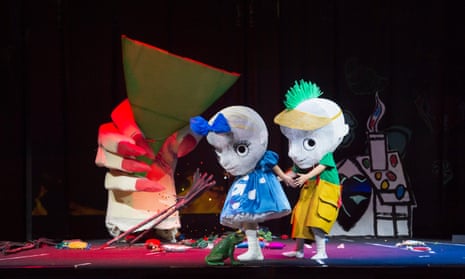Children, hardly a revelation, are not easy to please at the opera. A small boy spotted at Covent Garden for Semiramide – four hours of epic Rossini tragedy – must have been glad of the toy dog he thought to bring. His seat was empty by the interval. Few operas breach the unknowable gap between youthful fun and adult reward. Engelbert Humperdinck’s Hänsel und Gretel (1893), based on a Grimm brothers story and full of darkness and delight, heads the list.
Humperdinck’s fairytale opera found itself opening the new season at Berlin’s rebuilt Staatsoper Unter den Linden, closed from 2010 until two months ago but only now in full operation, four years late and at a cost of €400m. A few dozen white and gold balloons tied to the exterior columns of this once imperial neoclassical building – “neo” a lot things; variously damaged and bombed, it was imitatively rebuilt in 1955 during the GDR period – felt about right. The message was simple: business as usual, at last. A more glitzy launch might have been expected, with Daniel Barenboim, the company’s music director, at the helm rather than in the audience. Other potential openers fell by the wayside as the building stayed shut and the company remained in its temporary home (the Schiller theatre).

Premiered on 23 December 1893, conducted by Richard Strauss, Hänsel und Gretel at least has the merits of being a Christmas tradition. Last week the freshly gilded horseshoe of the Staatsoper, chandeliers sparkling, looking superficially much as before (more anon), was abuzz with families as well as VIPs. This fast-changing city revels in its collective identity, with two Berliners responsible for this production: Sebastian Weigle, one-time principal French horn in the company’s orchestra, conducted Humperdinck’s melodic, Wagner-inspired score. The staging was by Achim Freyer, 83, a veteran director who began his career as a student in Bertolt Brecht’s Berliner Ensemble, training with the luminaries of East German theatre (such as Ruth Berghaus) before coming west in 1972 and making a name in America.
Aspects of Freyer’s kooky approach guaranteed trouble. As the curtain went down on Act 1, a disgruntled juvenile let out a boo so prolonged and raucous you felt sorry for the parent. In fact it was a grownup throwing his critical faculties out of his front-stall seat. Hänsel und Gretel, a work so often first encountered in childhood, provokes keen passions. No doubt he wanted a real gingerbread house and a female witch who looked like a female witch instead of a man (Stephan Rügamer) dressed up as a priapic chimney sweep. (The role was written for a mezzo-soprano but is often taken by a tenor.)

Trained first as a painter, Freyer designed his own sets and costumes in singular fantasy-grunge style: whizzing, chalk-on-blackboard projections, tinsel and blown bubbles at any opportunity, a triangular, faceless Santa Claus as the magical Sandman, an elephant-shaped watering can as Dew Fairy. Swirling over all, a disco glitterball and an oppressive mood of anti-consumerism made a queasy impression. It had a certain charm and some fatal flaws.
Much of the action took place at the front of the stage, presumably to help children in the audience engage fully and see the workings of theatre. Hänsel (Katrin Wundsam) and Gretel (Elsa Dreisig) sang winningly, but were invisible beneath cute mesh heads in the generic manga-cum-Heidi style referred to as “Kindchenschema”. The performers proved surprisingly expressive and physically subtle as the evening progressed, but if you wanted the immediacy of human “children”, you’d be in a tantrum. The vile parents Peter (Roman Trekel) and Gertrud (Marina Prudenskaya), decidedly ripe for social services, could have been more fully characterised.
The real let down was the witch. Whereas the many excellent British productions of recent years – Richard Jones’s classic for Welsh National Opera, Laurent Pelly’s lurid, ecowarrior staging for Glyndebourne – have pushed horror as far as possible, here the staging seemed scared of itself. There might be many reasons a German director resists enacting in too much detail the story’s climax in which a stereotypical “ugly old woman” is pushed into an oven and burnt, as the text puts it, to a crisp.
I feared this too fanciful an explanation for a dull finale. Instead, political sensibility played a part. In a newspaper interview Freyer said that had he been forced to burn the witch he would not have gone ahead with the production. Witches were intelligent women, burnt because their way of thinking endangered the system; this should not, he continued, be a cause of jubilation. So in his version, the children throw adverts for a global chain selling useless products named after the witch, Rosina, into some flame-effect curtains. So much for neutering fairytales.

The previous night, as a celebration of the 275th birthday of the building – founded by Frederick II of Prussia and opened in 1742 – Barenboim conducted the resident Staatskapelle Berlin, star visitors at this year’s BBC Proms, in an orchestral programme of Mendelssohn, Boulez and Richard Strauss. In a brief speech, Barenboim said we should forget the delays and the millions of euros overspend and celebrate the glories of this restoration. The repertoire was chosen as a test for the incredible, adjusted acoustic, achieved by raising the domed ceiling by four metres and veiling the newly created reverberation gallery in a striking white lattice. All sounded crystalline yet warm. The revelation was the Boulez.
Notations I-IV and VII, serial works written for piano in 1945, were reworked three decades later for massive orchestra. Every player in the phenomenal Staatskapelle pulls their weight to the maximum. Eight percussionists positively bopped to and fro across a variety of marimba, vibraphone, tubular bells, glass chimes, wood blocks, cowbells and more. As rhythmically incisive as Stravinsky, as sensuous as Ravel, this concert was worth the seven-year wait.
Star ratings (out of 5)
Hänsel und Gretel ★★★
Staatsoper Berlin 275th birthday concert ★★★★★

Comments (…)
Sign in or create your Guardian account to join the discussion